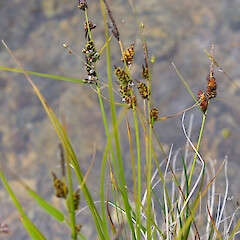Carex gaudichaudiana
Common name
Gaudichaud’s sedge
Synonyms
Carex vulgaris var. gaudichaudiana (Kunth) Boott
Family
Cyperaceae
Flora category
Vascular – Native
Endemic taxon
No
Endemic genus
No
Endemic family
No
Structural class
Sedges
NVS code
The National Vegetation Survey (NVS) Databank is a physical archive and electronic databank containing records of over 94,000 vegetation survey plots - including data from over 19,000 permanent plots. NVS maintains a standard set of species code abbreviations that correspond to standard scientific plant names from the Ngä Tipu o Aotearoa - New Zealand Plants database.
CARGAU
Chromosome number
2n = 72
Current conservation status
The conservation status of all known New Zealand vascular plant taxa at the rank of species and below were reassessed in 2017 using the New Zealand Threat Classification System (NZTCS) – more information about this can be found on the NZTCS website. This report includes a statistical summary and brief notes on changes since 2012 and replaces all previous NZTCS lists for vascular plants.
Please note, threat classifications are often suggested by authors when publications fall between NZTCS assessment periods – an interim threat classification status has not been assessed by the NZTCS panel.
- Conservation status of New Zealand indigenous vascular plants, 2017 . 2018. Peter J. de Lange, Jeremy R. Rolfe, John W. Barkla, Shannel P. Courtney, Paul D. Champion, Leon R. Perrie, Sarah M. Beadel, Kerry A. Ford, Ilse Breitwieser, Ines Schönberger, Rowan Hindmarsh-Walls, Peter B. Heenan and Kate Ladley. Department of Conservation. Source: NZTCS and licensed by DOC for reuse under the Creative Commons Attribution 4.0 International licence.
2017 | Not Threatened | Qualifiers: SO
Previous conservation statuses
2012 | Not Threatened
2009 | Not Threatened
2004 | Not Threatened
Distribution
Indigenous. New Zealand: North and South Islands from about the northern Waikato south. Also in Australia and New Guinea.
Habitat
Lowland to alpine in wetlands, bogs and mires, along river flats, in seepages, around the margins of lakes, ponds and tarns.
Wetland plant indicator status rating
Information derived from the revised national wetland plant list prepared to assist councils in delineating and monitoring wetlands (Clarkson et al., 2021 Manaaki Whenua – Landcare Research Contract Report LC3975 for Hawke’s Bay Regional Council). The national plant list categorises plants by the extent to which they are found in wetlands and not ‘drylands’. The indicator status ratings are OBL (obligate wetland), FACW (facultative wetland), FAC (facultative), FACU (facultative upland), and UPL (obligate upland). If you have suggestions for the Wetland Indicator Status Rating, please contact: [Enable JavaScript to view protected content]
OBL: Obligate Wetland
Almost always is a hydrophyte, rarely in uplands (non-wetlands).
Detailed description
Rhizome ascending; tufts flaccid. Rhizomes 1.5–2.0 mm diameter, often long-creeping. Culms variable in size, 20–320 × 0.3–1.0 mm, trigonous, almost glabrous, but often slightly scabrid just below the inflorescence; basal sheaths light brown or grey-brown. Leaves numerous, < or us. > culms, 0.5–2.5 mm wide, double-folded, grass-like, keel, margins and nerves on adaxial surface slightly scabrid towards tip. Inflorescence of 3–5 spikes, ± approximate, usually sessile; uppermost spike male, occasionally compound with a smaller male spike near its base; lower spikes female, often male at the top, 5–20 × 2–5 mm, usually < male spikes. Glumes < utricles, ovate, subacute, dark brown to almost black, coriaceous, midrib narrow to broad, green, scarcely reaching tip of glume. Utricles 2.5–4.0 × 1.5–2.0 mm, narrow-ovoid to orbicular-ovoid, gradually tapering above, much compressed, green with minute red-brown spots when mature, conspicuously nerved, margins smooth; beak almost wanting, orifice entire or minutely bidentate; stipe < 0.5 mm. long. Stigmas 2. Nut 1.5–2 mm. long, biconvex, orbicular-ovoid, dull grey.
Similar taxa
Carex gaudichaudiana is most similar to C. sinclairii Boott and C. subdola Boott from which it is easily distinguished by its overall smaller size, narrower leaves and sessile spikes.
Flowering
October–December
Fruiting
December–April
Life cycle
Nuts surrounded by inflated utricles are dispersed by granivory and wind (Thorsen et al., 2009).
Propagation technique
Easily grown from fresh seed and by the division of established plants. Although a wetland species, C. gaudichaudiana will grow well in most soils and moisture regimes. Does best in full sun.
Etymology
carex: Latin name for a species of sedge, now applied to the whole group.
gaudichaudiana: After Gaudichaud-Baupre
Attribution
Description adapted from Moore and Edgar (1970)
References and further reading
Moore LB, Edgar E. 1970. Flora of New Zealand, Volume II. Indigenous Tracheophyta: Monocotyledones except Gramineae. Government Printer, Wellington, NZ. 354 p.
Thorsen MJ, Dickinson KJM, Seddon PJ. 2009. Seed dispersal systems in the New Zealand flora. Perspectives in Plant Ecology, Evolution and Systematics 11: 285–309.










